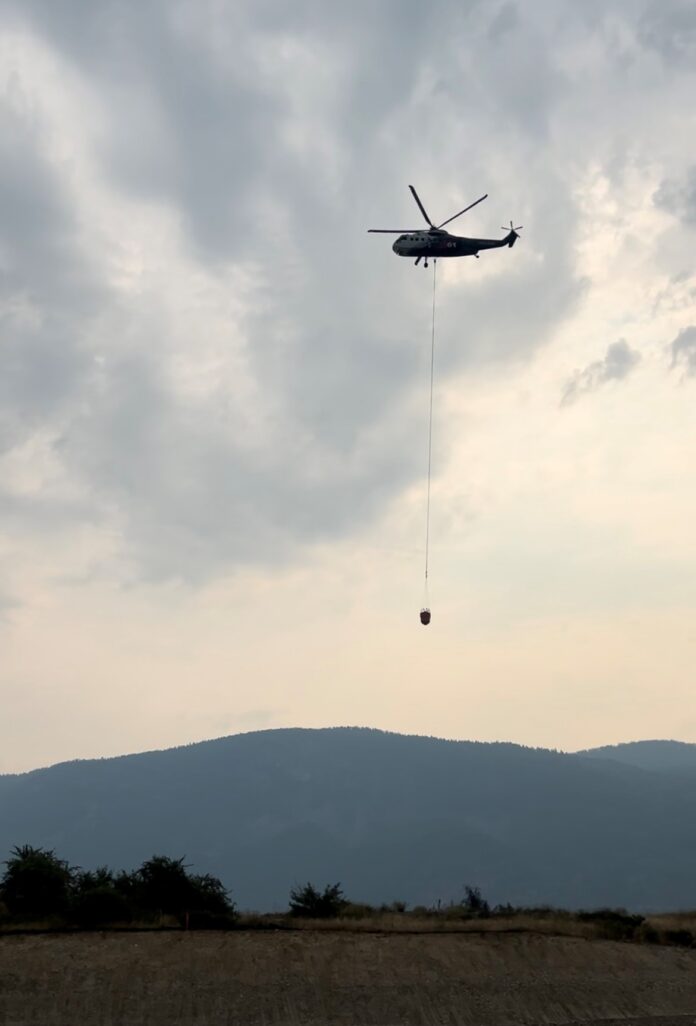Jason Lawler, Incident Commander with the South East Fire Centre’s Slocan Lake Fire Complex, has provided Vista Radio with an update on the current fires of note in the Slocan Valley.
Slocan Lake Fire Complex
The Slocan Fire Complex consists of three main fires: the Aylwin Creek fire, the Nemo Creek fire, and the Komonko Creek fire.
As of Wednesday, July 24, the fire at Aylwin Creek is 400 ha in size, Nemo Creek is listed as 823 ha in size, and the Komonko Creek wildfire is about 534 ha in size.
At this time, the wildfire service is bringing together local, provincial, national, and international resources to help battle the fires that are underway.
On Tuesday, air support was unable to assist land crews due to a layer of thick smoke over the region that limited access.
Although the smoke cleared up enough by Wednesday for both land and aviation crews to coordinate direct attacks, conditions still remain unfavourable.
“We’re still experiencing some high temperatures and some afternoon wind at higher elevations, so the conditions right now aren’t great for firefighting operations, but we certainly have crews and resources deployed in those community areas and we’re certainly doing the very best we can with what we have.”
The fires of most concern are obviously the ones closest to community infrastructure, stated Lawler.
Crews spent the day Wednesday ensuring control lines are in place to focus on critical areas of concern.
Reinforcements have been placed along the three fires closest to communities using protected water sprinklers, along with ground crews and aviation.
“We’re really focusing in on some of those more critical areas of the fires of obvious concern. The fires that are directly in or near values or structures in that area,” said Lawler.
“We’re also conscious of roadways that we’ve had to close for the safety of the community and first responders, and we understand that that can impact the community, but our first and foremost priority is the safety of the community and our first responders as we move through and try to get a hold of some of these fires.”
Evacuations
Hundreds of residents in the Regional District of Central Kootenay Electoral Area H have been forced to evacuate their homes as a result of the wildfire activity, and Lawler said it’s too difficult to say how long people will be displaced.
“We have to ensure that it is certainly safe for people to return, and that is something that is really difficult to put a metric on. The reality is we only go into an evacuation order as a last resort, but we’ll certainly do it in time to allow the public to get out safely.”
The community’s cooperation right now is critical to the effectiveness of the wildfire service’s response, with Lawler asking that people please obey any evacuation alerts, orders, and restrictions issued in the area.
“It’s really important that the community complies and understands that when the alerts are in place, and if an order is put in place, it’s essentially done for the safety of the community.”
Residents should ensure they stay informed and keep an eye out for the alerts and notifications sent out by the wildfire service to stay up to date on the wildfire activity in their area.
Area Restrictions
On July 22, an area restriction came into effect for the Slocan Lake Complex Area.
An area restriction, according to the BC Wildfire Service, is a legal order that prohibits access to certain areas to limit the risk of a fire, address public safety concerns, or avoid interference with fire control.
Lawler said the area restriction was put into place more for tourists rather than residents, as visitors entering the area may not have the local knowledge necessary to understand the risks in the area.
“That’s really to prevent unintended travellers or holidaymakers from entering areas that we consider to be at risk, but don’t have local knowledge and are potentially not equipped to understand the area they’re in that may become subject to fire.”
People are asked to be aware of the responders in the area and on the roads, with Lawler asking motorists to avoid driving in the Slocan Valley for the time being to ensure fire crews can do their job.
“If you don’t need to be on the road in the vicinity of those operations, then please take care on the roads. Also, in those areas where there are roads closed, please comply and adhere to the advice of those personnel that are out there making sure that the community is safe on the roadways.”
Where to find information
The BC Wildfire Service is the primary source of information for all wildfire activity.
Regional District Central Kootenay (RDCK) is the primary source of information for evacuation orders and evacuation alerts.
Drive BC for all information on roads and road closures.
Be the first to know! Don’t miss out on breaking news and daily updates in your area. Sign up to MyKootenayNow News Alerts.




